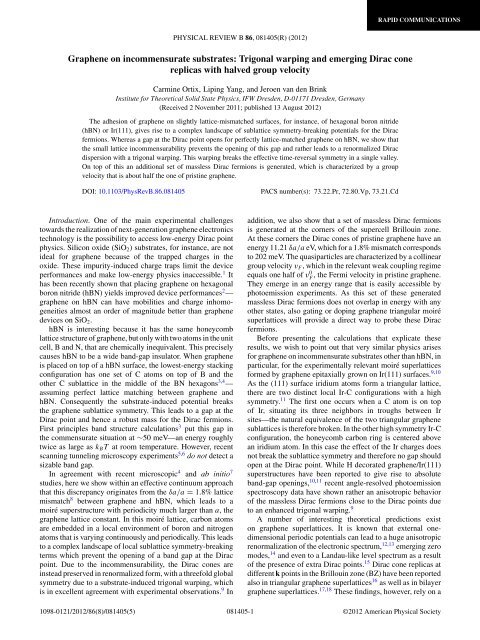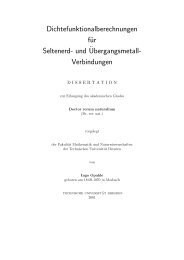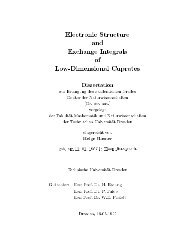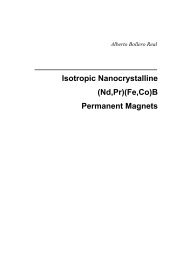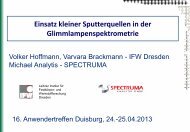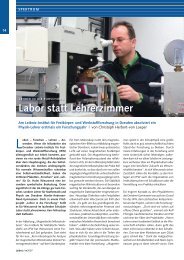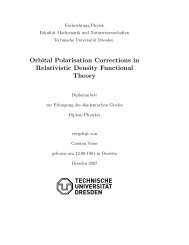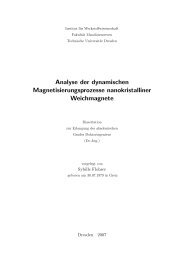Graphene on incommensurate substrates - APS Link Manager ...
Graphene on incommensurate substrates - APS Link Manager ...
Graphene on incommensurate substrates - APS Link Manager ...
You also want an ePaper? Increase the reach of your titles
YUMPU automatically turns print PDFs into web optimized ePapers that Google loves.
RAPID COMMUNICATIONS<br />
PHYSICAL REVIEW B 86, 081405(R) (2012)<br />
<str<strong>on</strong>g>Graphene</str<strong>on</strong>g> <strong>on</strong> <strong>incommensurate</strong> <strong>substrates</strong>: Trig<strong>on</strong>al warping and emerging Dirac c<strong>on</strong>e<br />
replicas with halved group velocity<br />
Carmine Ortix, Liping Yang, and Jeroen van den Brink<br />
Institute for Theoretical Solid State Physics, IFW Dresden, D-01171 Dresden, Germany<br />
(Received 2 November 2011; published 13 August 2012)<br />
The adhesi<strong>on</strong> of graphene <strong>on</strong> slightly lattice-mismatched surfaces, for instance, of hexag<strong>on</strong>al bor<strong>on</strong> nitride<br />
(hBN) or Ir(111), gives rise to a complex landscape of sublattice symmetry-breaking potentials for the Dirac<br />
fermi<strong>on</strong>s. Whereas a gap at the Dirac point opens for perfectly lattice-matched graphene <strong>on</strong> hBN, we show that<br />
the small lattice incommensurability prevents the opening of this gap and rather leads to a renormalized Dirac<br />
dispersi<strong>on</strong> with a trig<strong>on</strong>al warping. This warping breaks the effective time-reversal symmetry in a single valley.<br />
On top of this an additi<strong>on</strong>al set of massless Dirac fermi<strong>on</strong>s is generated, which is characterized by a group<br />
velocity that is about half the <strong>on</strong>e of pristine graphene.<br />
DOI: 10.1103/PhysRevB.86.081405<br />
PACS number(s): 73.22.Pr, 72.80.Vp, 73.21.Cd<br />
Introducti<strong>on</strong>. One of the main experimental challenges<br />
towards the realizati<strong>on</strong> of next-generati<strong>on</strong> graphene electr<strong>on</strong>ics<br />
technology is the possibility to access low-energy Dirac point<br />
physics. Silic<strong>on</strong> oxide (SiO 2 ) <strong>substrates</strong>, for instance, are not<br />
ideal for graphene because of the trapped charges in the<br />
oxide. These impurity-induced charge traps limit the device<br />
performances and make low-energy physics inaccessible. 1 It<br />
has been recently shown that placing graphene <strong>on</strong> hexag<strong>on</strong>al<br />
bor<strong>on</strong> nitride (hBN) yields improved device performances 2 —<br />
graphene <strong>on</strong> hBN can have mobilities and charge inhomogeneities<br />
almost an order of magnitude better than graphene<br />
devices <strong>on</strong> SiO 2 .<br />
hBN is interesting because it has the same h<strong>on</strong>eycomb<br />
lattice structure of graphene, but <strong>on</strong>ly with two atoms in the unit<br />
cell, B and N, that are chemically inequivalent. This precisely<br />
causes hBN to be a wide band-gap insulator. When graphene<br />
is placed <strong>on</strong> top of a hBN surface, the lowest-energy stacking<br />
c<strong>on</strong>figurati<strong>on</strong> has <strong>on</strong>e set of C atoms <strong>on</strong> top of B and the<br />
other C sublattice in the middle of the BN hexag<strong>on</strong>s 3,4 —<br />
assuming perfect lattice matching between graphene and<br />
hBN. C<strong>on</strong>sequently the substrate-induced potential breaks<br />
the graphene sublattice symmetry. This leads to a gap at the<br />
Dirac point and hence a robust mass for the Dirac fermi<strong>on</strong>s.<br />
First principles band structure calculati<strong>on</strong>s 3 put this gap in<br />
the commensurate situati<strong>on</strong> at ∼50 meV—an energy roughly<br />
twice as large as k B T at room temperature. However, recent<br />
scanning tunneling microscopy experiments 5,6 do not detect a<br />
sizable band gap.<br />
In agreement with recent microscopic 4 and ab initio 7<br />
studies, here we show within an effective c<strong>on</strong>tinuum approach<br />
that this discrepancy originates from the δa/a = 1.8% lattice<br />
mismatch 8 between graphene and hBN, which leads to a<br />
moiré superstructure with periodicity much larger than a, the<br />
graphene lattice c<strong>on</strong>stant. In this moiré lattice, carb<strong>on</strong> atoms<br />
are embedded in a local envir<strong>on</strong>ment of bor<strong>on</strong> and nitrogen<br />
atoms that is varying c<strong>on</strong>tinuously and periodically. This leads<br />
to a complex landscape of local sublattice symmetry-breaking<br />
terms which prevent the opening of a band gap at the Dirac<br />
point. Due to the incommensurability, the Dirac c<strong>on</strong>es are<br />
instead preserved in renormalized form, with a threefold global<br />
symmetry due to a substrate-induced trig<strong>on</strong>al warping, which<br />
is in excellent agreement with experimental observati<strong>on</strong>s. 9 In<br />
additi<strong>on</strong>, we also show that a set of massless Dirac fermi<strong>on</strong>s<br />
is generated at the corners of the supercell Brillouin z<strong>on</strong>e.<br />
At these corners the Dirac c<strong>on</strong>es of pristine graphene have an<br />
energy 11.21 δa/a eV, which for a 1.8% mismatch corresp<strong>on</strong>ds<br />
to 202 meV. The quasiparticles are characterized by a collinear<br />
group velocity v F , which in the relevant weak coupling regime<br />
equals <strong>on</strong>e half of vF 0 , the Fermi velocity in pristine graphene.<br />
They emerge in an energy range that is easily accessible by<br />
photoemissi<strong>on</strong> experiments. As this set of these generated<br />
massless Dirac fermi<strong>on</strong>s does not overlap in energy with any<br />
other states, also gating or doping graphene triangular moiré<br />
superlattices will provide a direct way to probe these Dirac<br />
fermi<strong>on</strong>s.<br />
Before presenting the calculati<strong>on</strong>s that explicate these<br />
results, we wish to point out that very similar physics arises<br />
for graphene <strong>on</strong> <strong>incommensurate</strong> <strong>substrates</strong> other than hBN, in<br />
particular, for the experimentally relevant moiré superlattices<br />
formed by graphene epitaxially grown <strong>on</strong> Ir(111) surfaces. 9,10<br />
As the (111) surface iridium atoms form a triangular lattice,<br />
there are two distinct local Ir-C c<strong>on</strong>figurati<strong>on</strong>s with a high<br />
symmetry. 11 The first <strong>on</strong>e occurs when a C atom is <strong>on</strong> top<br />
of Ir, situating its three neighbors in troughs between Ir<br />
sites—the natural equivalence of the two triangular graphene<br />
sublattices is therefore broken. In the other high symmetry Ir-C<br />
c<strong>on</strong>figurati<strong>on</strong>, the h<strong>on</strong>eycomb carb<strong>on</strong> ring is centered above<br />
an iridium atom. In this case the effect of the Ir charges does<br />
not break the sublattice symmetry and therefore no gap should<br />
open at the Dirac point. While H decorated graphene/Ir(111)<br />
superstructures have been reported to give rise to absolute<br />
band-gap openings, 10,11 recent angle-resolved photoemissi<strong>on</strong><br />
spectroscopy data have shown rather an anisotropic behavior<br />
of the massless Dirac fermi<strong>on</strong>s close to the Dirac points due<br />
to an enhanced trig<strong>on</strong>al warping. 9<br />
A number of interesting theoretical predicti<strong>on</strong>s exist<br />
<strong>on</strong> graphene superlattices. It is known that external <strong>on</strong>edimensi<strong>on</strong>al<br />
periodic potentials can lead to a huge anisotropic<br />
renormalizati<strong>on</strong> of the electr<strong>on</strong>ic spectrum, 12,13 emerging zero<br />
modes, 14 and even to a Landau-like level spectrum as a result<br />
of the presence of extra Dirac points. 15 Dirac c<strong>on</strong>e replicas at<br />
different k points in the Brillouin z<strong>on</strong>e (BZ) have been reported<br />
also in triangular graphene superlattices 16 as well as in bilayer<br />
graphene superlattices. 17,18 These findings, however, rely <strong>on</strong> a<br />
1098-0121/2012/86(8)/081405(5) 081405-1<br />
©2012 American Physical Society
RAPID COMMUNICATIONS<br />
CARMINE ORTIX, LIPING YANG, AND JEROEN VAN DEN BRINK PHYSICAL REVIEW B 86, 081405(R) (2012)<br />
descripti<strong>on</strong> that disregards local sublattice symmetry-breaking<br />
terms, which are crucial when investigating the opening and<br />
closing of gaps in graphene <strong>on</strong> slightly <strong>incommensurate</strong> hBN<br />
or Ir(111). In this Rapid Communicati<strong>on</strong>, we investigate the<br />
modificati<strong>on</strong> of the electr<strong>on</strong>ic spectrum of graphene moiré<br />
superlattices, taking explicitly into account these essential,<br />
slowly varying, sublattice symmetry-breaking terms in an<br />
effective c<strong>on</strong>tinuum approach.<br />
Effective Hamilt<strong>on</strong>ian. We start out by taking into account<br />
the interacti<strong>on</strong> induced by the substrate charges as an external<br />
electrostatic potential for graphene’s Dirac electr<strong>on</strong>s. The<br />
potential has a triangular periodicity that coincides with<br />
the arrangements of the centers of the BN hexag<strong>on</strong>s (Ir<br />
atoms at the 111 surface), V(r) = ∑ G V Ge iG·r , where the G’s<br />
are the reciprocal lattice vectors and V G the corresp<strong>on</strong>ding<br />
amplitudes whose magnitudes depend <strong>on</strong> the modulus of<br />
G al<strong>on</strong>e. In the following, we restrict the sum to the six<br />
wave vectors with equal magnitude G = 4π/(3 a S ), G/G =<br />
(±1,0),(± cos π/3, ± sin π/3), where √ 3 a S indicates the BN<br />
hexag<strong>on</strong>s (Ir-Ir) distance. As the mismatch between a S and the<br />
graphene carb<strong>on</strong>-carb<strong>on</strong> distance a is small, we can evaluate<br />
the effect of the substrate-induced electrostatic potential <strong>on</strong><br />
the two triangular graphene sublattices A/B as the sum<br />
of products of rapidly varying parts exp(iG SR · r A/B<br />
j<br />
), r A/B<br />
j<br />
being the actual atomic positi<strong>on</strong>s and G SR rescaled wave<br />
vectors with magnitude G SR = 4π/(3 a), times slowly varying<br />
parts exp(i˜G · r) which we treat in the c<strong>on</strong>tinuum limit.<br />
The ˜G’s are the rescaled “coarse-grained” wave vectors with<br />
magnitude ˜G = 4π|δa|/3a 2 , where δa = a S − a indicates the<br />
lattice mismatch which without loss of generality has been<br />
assumed to be positive. As a result, the effect of the substrate<br />
charges leads to an average external potential acting equally<br />
<strong>on</strong> each carb<strong>on</strong> atom and a mass term breaking the graphene<br />
sublattice symmetry given by V ± (r) = [V A (r) ± V B (r)]/2 =<br />
V 0 /2 ∑˜G [1 ± exp iφ˜G] × exp(i˜G · r). The c<strong>on</strong>tributi<strong>on</strong> of the<br />
rapidly varying parts of the potential are now encoded in the<br />
n<strong>on</strong>trivial phase factors φ˜G =−G SR · δ, where δ =−a(1,0)<br />
is the graphene nearest-neighbor vector and G SR ‖ ˜G.<br />
Since the large periodicity of the moiré superstructure<br />
prevents intervalley scattering, we can describe the<br />
low-energy quasiparticles near the corners K ± ={2π/(3a),<br />
±2π/(3 √ 3a)} of the graphene hexag<strong>on</strong>al Brillouin z<strong>on</strong>e as<br />
four-dimensi<strong>on</strong>al spinors = [ψ K+ ,A,ψ K+ ,B,ψ K− ,B,ψ K− ,A],<br />
characterizing the electr<strong>on</strong>ic amplitudes <strong>on</strong> the two crystalline<br />
sublattices, with an effective Hamilt<strong>on</strong>ian in the valley<br />
isotropic representati<strong>on</strong> 19<br />
Ĥ = v 0 F τ 0 ⊗ p · σ + V + (r)τ 0 ⊗ σ 0 + V − (r)τ z ⊗ σ z . (1)<br />
Here we use direct products of Pauli matrices σ x,y,z , σ 0 ≡ ˆ1<br />
acting in the sublattice space and τ x,y,z ,τ 0 ≡ ˆ1 acting <strong>on</strong> the<br />
valley degree of freedom (K ± ).<br />
For V ± (r) ≡ 0, Ĥ has a chiral symmetry which can be<br />
expressed as {Ĥ,τ 0 ⊗ σ z }≡0. This anticommutati<strong>on</strong> relati<strong>on</strong><br />
implies that in each valley any eigenstate ɛ with energy ɛ has a<br />
particle-hole partner τ 0 ⊗ σ z with energy −ɛ. This property<br />
implies the double degeneracy of the zero-energy states in<br />
each valley. In the presence of substrate-induced interacti<strong>on</strong>s<br />
of the form as in Eq. (1), the system still possesses a chiral<br />
symmetry provided the external superlattice potentials satisfy<br />
(a)<br />
v F<br />
/ v F<br />
0<br />
1.0<br />
0.9<br />
0.8<br />
0.7<br />
0.6<br />
0.5<br />
0 0.1 0.2 0.3 0.4<br />
ε F<br />
-ε D<br />
=0.05<br />
0.1<br />
0.05<br />
k y<br />
0<br />
-0.05<br />
-0.1<br />
-0.1 -0.05 0 0.05 0.1<br />
ε D<br />
k y<br />
0.6<br />
0.4<br />
0.2<br />
0<br />
-0.2<br />
-0.4<br />
-0.6<br />
-1.0 -0.5 0 0.5 1.0<br />
(c) (d) ε F<br />
-ε D<br />
=0.05<br />
(b)<br />
0.1<br />
0.05<br />
0<br />
-0.05<br />
-0.1<br />
-0.1 -0.05 0 0.05 0.1<br />
FIG. 1. (Color <strong>on</strong>line) (a) Renormalizati<strong>on</strong> of the Fermi velocity<br />
at the Dirac point as a functi<strong>on</strong> of V 0 . The points are the results of<br />
the exact diag<strong>on</strong>alizati<strong>on</strong> of the low-energy Hamilt<strong>on</strong>ian whereas the<br />
c<strong>on</strong>tinuous line is the analytical result from sec<strong>on</strong>d-order perturbati<strong>on</strong><br />
theory. (b) Energy of the Dirac point as a functi<strong>on</strong> of the external<br />
potential amplitude V 0 . (c), (d) Fermi lines for different values of the<br />
potential amplitude V 0 close to the K + (c) and the K − (d) valleys.<br />
Energies and wave vectors are in units of ¯hv F ˜G and ˜G, respectively.<br />
V ± (r + T) =−V ± (r). In this case it is possible to define a<br />
new chiral operator 15 τ 0 ⊗ σ z S, where S is a shift operator<br />
S(r) = (r + T). For the electrostatic potentials defined<br />
above, a translati<strong>on</strong> vector for which the triangular potential<br />
V + (r + T) ≡−V + (r) is absent, thereby implying particle-hole<br />
symmetry breaking and a c<strong>on</strong>sequent lifting of the zero-energy<br />
state degeneracy.<br />
This, however, does not lead to the opening of any absolute<br />
band gap since the ˜G ≡ 0 comp<strong>on</strong>ent of the local sublattice<br />
symmetry-breaking terms identically vanishes. 4 Therefore,<br />
the Dirac c<strong>on</strong>es are preserved with the effect of particle-hole<br />
asymmetry eventually leading to a shift of the c<strong>on</strong>ical points<br />
[shown in Fig. 1(b)] of the two valleys, reminiscent of the<br />
graphene doping caused by adsorpti<strong>on</strong> of metal <strong>substrates</strong>. 20<br />
We also find the Dirac c<strong>on</strong>es to be renormalized in triangular<br />
moiré superlattices. In Fig. 1(a) we show the behavior of the<br />
collinear Fermi velocity at the c<strong>on</strong>ical points for different<br />
values of the interacti<strong>on</strong> strength V 0 . The substrate-induced<br />
interacti<strong>on</strong> leads to a decrease of the Fermi velocity, 21 as can<br />
be found in the weak potential limit by treating the effect of<br />
the electrostatic potentials in sec<strong>on</strong>d-order perturbati<strong>on</strong> theory<br />
[cf. the c<strong>on</strong>tinuous line in Fig. 1(b)] according to which<br />
v F = vF<br />
[1 0 − 6V 0<br />
2 ]<br />
¯h 2 vF 02 ˜G .<br />
2<br />
The local sublattice symmetry-breaking term breaks the<br />
effective time-reversal symmetry <strong>on</strong> a single valley, 22<br />
˜T = i(τ 0 ⊗ σ y ) C, ˆ with Cˆ<br />
the operator of complex<br />
c<strong>on</strong>jugati<strong>on</strong> and ˜T [ψ K+ ,A,ψ K+ ,B,ψ K− ,B,ψ K− ,A] = [ψK ⋆ + ,B ,<br />
−ψK ⋆ + ,A ,ψ K ⋆ − ,A , −ψ K ⋆ − ,B]. This is clearly visible in Figs. 1(c)<br />
and 1(d), where we show the topology of the Fermi lines<br />
close to the Dirac points in the two graphene valleys. There<br />
is a trig<strong>on</strong>al warping which breaks the k →−k symmetry of<br />
the Fermi lines, i.e., ɛ(K ± ,k) ≠ ɛ(K ± , −k), c<strong>on</strong>sistent with<br />
081405-2
RAPID COMMUNICATIONS<br />
GRAPHENE ON INCOMMENSURATE SUBSTRATES: ... PHYSICAL REVIEW B 86, 081405(R) (2012)<br />
the threefold symmetry of the band structure experimentally<br />
detected in Ir(111) superlattices. 9 The trig<strong>on</strong>al warping has<br />
an opposite effect <strong>on</strong> the two valleys since the external<br />
electrostatic potentials do not break the true time-reversal<br />
symmetry interchanging the valleys 22 T =−(τ y ⊗ σ y ) Cˆ<br />
with T [ψ K+ ,A,ψ K+ ,B,ψ K− ,B,ψ K− ,A] = [ψK ⋆ − ,A , −ψ K ⋆ − ,B ,<br />
−ψK ⋆ + ,B ,ψ K ⋆ + ,A]. Hence, the Fermi lines fulfill<br />
ɛ(K ± ,k) ≡ ɛ(K ∓ , −k), as can been shown in the weak<br />
potential limit where the energy dispersi<strong>on</strong> of the low-energy<br />
quasiparticles reads<br />
ɛ(K ± ,k) ≃ ¯hv F s|k|∓ 3√ 3s |k| 2<br />
¯hvF<br />
0 ˜G V 2<br />
3 0 sin 3θ k. (2)<br />
Here θ k is the angle of the vector k with respect to the<br />
ˆk x directi<strong>on</strong> and s =±1 for quasielectr<strong>on</strong>s and quasiholes,<br />
respectively. By increasing the strength of the potential V 0<br />
[cf. Figs. 1(c) and 1(d)], the warping effect is enhanced and<br />
results in an anisotropy much larger than the <strong>on</strong>e expected in<br />
freestanding graphene. 9<br />
Emergence of Dirac c<strong>on</strong>e replicas. We have also obtained<br />
the energy dispersi<strong>on</strong> in the full supercell Brillouin z<strong>on</strong>e (SBZ)<br />
by exact diag<strong>on</strong>alizati<strong>on</strong> of the Hamilt<strong>on</strong>ian Eq. (1). The<br />
effect of the substrate-induced external potential V ± (r) has<br />
been incorporated into our calculati<strong>on</strong>s through the scattering<br />
matrix elements between the chiral eigenstates of the graphene<br />
quasiparticles<br />
(<br />
ψK± ,A<br />
)<br />
ψ s (K ± ,k) = = 1 ( ) 1<br />
√<br />
ψ K± ,B 2 se ±iθ e i k·r .<br />
k<br />
Figure 2 shows the ensuing energy dispersi<strong>on</strong> of the first and<br />
sec<strong>on</strong>d bands above and below the original Dirac points in<br />
each valley. C<strong>on</strong>trary to Ref. 16 we do not find a generati<strong>on</strong> of<br />
Dirac c<strong>on</strong>es at the six ˜M points of the SBZ. Indeed, the energy<br />
separati<strong>on</strong> between the first and the sec<strong>on</strong>d band above and<br />
below the original Dirac points goes to zero, respectively, at<br />
the (K ± ,˜K ± ), (K ± ,˜K ∓ ) corners of the SBZ. This qualitative<br />
difference is caused by the sublattice symmetry-breaking term<br />
V − (r) which does not allow for a sixfold symmetry of the band<br />
structure. The topology of the Fermi lines close to the SBZ<br />
corners clearly shows the emergence of Dirac c<strong>on</strong>e replicas.<br />
However, while above the original Dirac points [cf. Fig. 2(c)]<br />
these new massless quasiparticles are obscured by other states,<br />
below the original Dirac points there is an energy window<br />
where there are no other states than these new massless Dirac<br />
fermi<strong>on</strong>s. Therefore there is <strong>on</strong>e energy value—apart from<br />
the original Dirac point—where the density of states (DOS)<br />
vanishes linearly. It is worth noticing that this asymmetry of the<br />
DOS reflects the particle-hole symmetry breaking discussed<br />
above.<br />
Further insight into the properties of the Dirac c<strong>on</strong>e<br />
replicas is obtained by introducing an effective Hamilt<strong>on</strong>ian<br />
close to the three equivalent corners of the SBZ. 23 In the<br />
following we will restrict to c<strong>on</strong>sider the behavior close to<br />
the (K ± ,˜K ∓ ) points, relevant for the Dirac c<strong>on</strong>e replicas<br />
generated below the original Dirac points. In the absence of<br />
external electrostatic potentials V ± (r) ≡ 0, there are three degenerate<br />
hole excitati<strong>on</strong>s with energy ɛ(K ± ,˜K ∓ ) =−¯hv F ˜K.<br />
This degeneracy is lifted by the substrate-induced electrostatic<br />
potentials and, as a result, <strong>on</strong>e finds a singlet excitati<strong>on</strong> with<br />
energy ɛ S (K ± ,˜K ∓ ) =−¯hv F ˜K − V 0 and a doubly degenerate<br />
state with energy ɛ D (K ± ,˜K ∓ ) =−¯hv F ˜K + V 0 /2. It can be<br />
easily shown that the effective Hamilt<strong>on</strong>ian in the vicinity<br />
of this doubly degenerate state corresp<strong>on</strong>ds precisely to a<br />
massless two-dimensi<strong>on</strong>al Dirac equati<strong>on</strong> with Fermi velocity<br />
vF R = v0 F<br />
/2 and an isotropic dispersi<strong>on</strong> relati<strong>on</strong><br />
ɛ D (K ± ,δk ± ) = ɛ D (K ± ,˜K ∓ ) + ¯h v0 F<br />
2 s′ δk ± , (3)<br />
(a) (b) (c) ε F<br />
=0.47<br />
ε F<br />
=0.49<br />
ε<br />
0.5<br />
0<br />
ε<br />
0.6<br />
0.4<br />
0.5<br />
0.2<br />
k 0 y<br />
-0.2<br />
-0.4<br />
-0.6<br />
0<br />
-0.6 -0.4 -0.2 0 0.2 0.4 0.6<br />
0.6<br />
0.4<br />
0.2<br />
k 0 y<br />
-0.2<br />
-0.4<br />
-0.6<br />
-0.6 -0.4-0.2 0 0.2 0.4 0.6<br />
k x<br />
k x<br />
-0.5<br />
-0.5<br />
-0.5<br />
-0.5<br />
0<br />
k 0.5<br />
0<br />
y 0.5<br />
0<br />
-0.5<br />
k<br />
k y<br />
x<br />
0.5<br />
-0.5<br />
0<br />
k x<br />
0.5<br />
ε F<br />
=-0.54 ε F<br />
=-0.51<br />
0.6<br />
0.4<br />
0.6<br />
0.4<br />
0.2<br />
0.2<br />
k 0 y<br />
-0.2<br />
k y 0<br />
-0.2<br />
-0.4<br />
-0.4<br />
-0.6<br />
-0.6<br />
-0.6-0.4-0.2 0 0.2 0.4 0.6<br />
-0.6 -0.4-0.2 0 0.2 0.4 0.6<br />
k x<br />
k x<br />
FIG. 2. (Color <strong>on</strong>line) Energy dispersi<strong>on</strong> relati<strong>on</strong>s for a graphene triangular moiré superlattice with V 0 = 0.1¯hv 0 F ˜G close to the two<br />
graphene valleys K + (a) and K − (b). The arrows indicate the corners ˜K ± of the SBZ where the Dirac c<strong>on</strong>e replicas are generated. (c) Topology<br />
of the Fermi lines close to the emergent Dirac c<strong>on</strong>es. Units are the same as in Fig. 1.<br />
081405-3
RAPID COMMUNICATIONS<br />
CARMINE ORTIX, LIPING YANG, AND JEROEN VAN DEN BRINK PHYSICAL REVIEW B 86, 081405(R) (2012)<br />
(a)<br />
-0.40<br />
0.75<br />
-0.45<br />
0.70<br />
ε -0.50<br />
0.65<br />
D<br />
0.60<br />
-0.55<br />
0.55<br />
-0.60<br />
0 0.1 0.2 0.3 0.4 0.5<br />
0.50<br />
0 0.1 0.2 0.3 0.4 0.5<br />
(c)<br />
ε F<br />
-ε D<br />
=0.05<br />
0.1<br />
0.05<br />
k y<br />
0<br />
-0.05<br />
-0.1<br />
-0.1 -0.05 0 0.05 0.1<br />
(b)<br />
(d)<br />
0.80<br />
0.1<br />
0.05<br />
0<br />
-0.05<br />
ε F<br />
-ε D<br />
=0.05<br />
-0.1<br />
-0.1 -0.05 0 0.05 0.1<br />
FIG. 3. (Color <strong>on</strong>line) Behavior of the Dirac point energy<br />
ɛ D (K ± ,˜K ∓ ) (a) as a functi<strong>on</strong> of the external potential amplitude<br />
V 0 . The c<strong>on</strong>tinuous line is the result of the degenerate perturbati<strong>on</strong><br />
theory whereas the points are the result of the exact diag<strong>on</strong>alizati<strong>on</strong>.<br />
(b) Group velocity at the Dirac point replicas as a functi<strong>on</strong> of the<br />
strength of the potential V 0 . (c), (d) Fermi lines close to the emergent<br />
Dirac points ɛ D (K + ,˜K − ) (c) and ɛ D (K − ,˜K + ) (d) for different values<br />
of the amplitude V 0 . Units are the same as in Fig. 1.<br />
where we introduced δk ± = k − ˜K ∓ and s ′ =±1 is the<br />
band index. The foregoing weak coupling analysis is in<br />
perfect agreement with the numerical results obtained by exact<br />
diag<strong>on</strong>alizati<strong>on</strong> of the Hamilt<strong>on</strong>ian. This is shown in Figs. 3(a)<br />
and 3(b) where we plot the behavior of the Dirac point energy<br />
ɛ D (K ± ,˜K ∓ ) and the Fermi velocity vF<br />
R as a functi<strong>on</strong> of the<br />
potential strength V 0 . Away from but close to the Dirac points,<br />
we find a trig<strong>on</strong>al warping respecting the threefold symmetry<br />
of the band structure, as it is shown in Figs. 3(c) and 3(d)<br />
where we plot the Fermi lines for different values of V 0 .<br />
For moiré superlattices of 100 unit cells and depending<br />
<strong>on</strong> the precise strength of the interacti<strong>on</strong> between the<br />
graphene and substrate, the typical energy of the emerging<br />
Dirac points is 100–200 meV, which is also the relevant<br />
energy regime for graphene <strong>on</strong> hBN. Such a value can be<br />
reached in the experimental realm, for instance, by applying<br />
a back gate voltage or doping graphene by adsorpti<strong>on</strong> <strong>on</strong><br />
metal <strong>substrates</strong>. 20 Even more, with the set of the potential<br />
parameters of Fig. 2, the energy window in which the emerging<br />
Dirac c<strong>on</strong>es do not overlap with other states is ∼42 meV, much<br />
larger than room-temperature thermal energy. This energy<br />
window can in principle be tuned by changing the superlattice<br />
parameters.<br />
C<strong>on</strong>clusi<strong>on</strong>s. By setting up an effective c<strong>on</strong>tinuum approach,<br />
we have derived the electr<strong>on</strong>ic properties of graphene<br />
moiré superlattices generated by adhesi<strong>on</strong> of graphene sheets<br />
<strong>on</strong>to lattice-mismatched <strong>substrates</strong>. While the complex landscape<br />
of sublattice symmetry-breaking terms prevents the<br />
opening of a band gap at the Dirac point, 4,7 we have dem<strong>on</strong>strated<br />
that with mismatched <strong>substrates</strong> <strong>on</strong>e can tailor the lowenergy<br />
band dispersi<strong>on</strong>—in the experimental realm this can<br />
be achieved for instance by engineering the mismatch angle<br />
am<strong>on</strong>g the hBN and the graphene layer. In agreement with<br />
recent experiments, 9 we have found a threefold symmetry of<br />
the band structure associated with a substrate-induced trig<strong>on</strong>al<br />
warping of the Dirac c<strong>on</strong>es and an anisotropic reducti<strong>on</strong> of the<br />
Fermi velocity, possibly leading to an enhanced localizati<strong>on</strong><br />
of the massless Dirac fermi<strong>on</strong>s. 21<br />
In additi<strong>on</strong>, a set of Dirac fermi<strong>on</strong>s is generated in graphene<br />
moiré superlattices. By properly and explicitly accounting for<br />
local sublattice symmetry terms, we have shown that these<br />
quasiparticles are generated at the corners of the supercell<br />
Brillouin z<strong>on</strong>e and are characterized by a collinear group<br />
velocity at the c<strong>on</strong>ical points of ∼v 0 F /2.<br />
Note added. Recently, a scanning tunneling microscopy<br />
experiment <strong>on</strong> graphene <strong>on</strong> hBN has shown the emergence of<br />
superlattice Dirac c<strong>on</strong>es with a Fermi velocity of about 58%<br />
the pristine graphene <strong>on</strong>e. 24<br />
Acknowledgments. L.Y. thanks F. Guinea for valuable<br />
discussi<strong>on</strong>s. This research was supported by the Dutch Science<br />
Foundati<strong>on</strong> NWO/FOM.<br />
1 J. Martin, N. Akerman, G. Ulbricht, T. Lohmann, J. H. Smet,<br />
K. v<strong>on</strong> Klitzing, and A. Yacoby, Nat. Phys. 4, 144 (2008).<br />
2 C. R. Dean, A. F. Young, I. Meric, C. Lee, L. Wang, S. Sorgenfrei,<br />
K. Watanabe, T. Taniguchi, P. Kim, K. L. Shepard, and J. H<strong>on</strong>e,<br />
Nat. Nano. 5, 722 (2010).<br />
3 G. Giovannetti, P. A. Khomyakov, G. Brocks, P. J. Kelly, and J. van<br />
den Brink, Phys.Rev.B76, 073103 (2007).<br />
4 B. Sachs, T. O. Wehling, M. I. Katsnels<strong>on</strong>, and A. I. Lichtenstein,<br />
Phys.Rev.B84, 195414 (2011).<br />
5 J. Xue, J. Sanchez-Yamagishi, D. Bulmash, P. Jacquod,<br />
A. Deshpande, K. Watanabe, T. Taniguchi, P. Jarillo-Herrero, and<br />
B. J. LeRoy, Nat. Mater. 10, 282 (2011).<br />
6 R. Decker, Y. Wang, V. W. Brar, W. Regan, H.-Z. Tsai, Q. Wu,<br />
W. Gannett, A. Zettl, and M. F. Crommie, Nano Lett. 11, 2291<br />
(2011).<br />
7 N. Karche and S. K. Nayak, Nano Lett. 11, 5274 (2011)<br />
8 L. Liu, Y. P. Feng, and Z. X. Shen, Phys. Rev. B 68, 104102<br />
(2003).<br />
9 S. Rusp<strong>on</strong>i, M. Papagno, P. Moras, S. Vlaic, M. Etzkorn, P. M.<br />
Sheverdyaeva, D. Pacilé, H. Brune, and C. Carb<strong>on</strong>e, Phys. Rev.<br />
Lett. 105, 246803 (2010).<br />
10 R. Balog, B. Jorgensen, L. Nilss<strong>on</strong>, M. Andersen, E. Rienks,<br />
M. Bianchi, M. Fanetti, E. Laegsgaard, A. Baraldi, S. Lizzit,<br />
Z. Sljivancanin, F. Besenbacher, B. Hammer, T. G. Pedersen,<br />
P. Hofmann, and L. Hornekaer, Nat. Mater. 9, 315 (2010).<br />
11 J. van den Brink, Nat. Mater. 9, 291 (2010).<br />
12 C.-H. Park, L. Yang, Y.-W. S<strong>on</strong>, M. L. Cohen, and S. G. Louie, Nat.<br />
Phys. 4, 213 (2008).<br />
13 C.-H. Park, Y.-W. S<strong>on</strong>, L. Yang, M. L. Cohen, and S. G. Louie,<br />
Nano Lett. 8, 2920 (2008).<br />
14 L. Brey and H. A. Fertig, Phys. Rev. Lett. 103, 046809<br />
(2009).<br />
15 J. Sun, H. A. Fertig, and L. Brey, Phys.Rev.Lett.105, 156801<br />
(2010).<br />
16 C.-H. Park, L. Yang, Y.-W. S<strong>on</strong>, M. L. Cohen, and S. G. Louie,<br />
Phys. Rev. Lett. 101, 126804 (2008).<br />
081405-4
RAPID COMMUNICATIONS<br />
GRAPHENE ON INCOMMENSURATE SUBSTRATES: ... PHYSICAL REVIEW B 86, 081405(R) (2012)<br />
17 M. Killi, S. Wu, and A. Paramekanti, Phys.Rev.Lett.107, 086801<br />
(2011).<br />
18 L. Z. Tan, C.-H. Park, and S. G. Louie, Nano Lett. 11, 2596<br />
(2011).<br />
19 A. R. Akhmerov and C. W. J. Beenakker, Phys.Rev.Lett.98,<br />
157003 (2007).<br />
20 G. Giovannetti, P. A. Khomyakov, G. Brocks, V. M. Karpan, J. van<br />
den Brink, and P. J. Kelly, Phys.Rev.Lett.101, 026803 (2008).<br />
21 G. Trambly de Laissardiére, D. Mayou, and L. Magaud, Nano Lett.<br />
10, 804 (2010).<br />
22 C. W. J. Beenakker, Rev. Mod. Phys. 80, 1337 (2008).<br />
23 F. Guinea and T. Low, Philos. Trans. R. Soc. L<strong>on</strong>d<strong>on</strong> A 368, 5391<br />
(2010).<br />
24 M. Yankowitz, J. Xue, D. Cormode, J. D. Sanchez-Yamagishi,<br />
K. Watanabe, T. Taniguchi, P. Jarillo-Herrero, P. Jacquod, and B. J.<br />
LeRoy, Nat. Phys. 8, 382 (2012).<br />
081405-5


